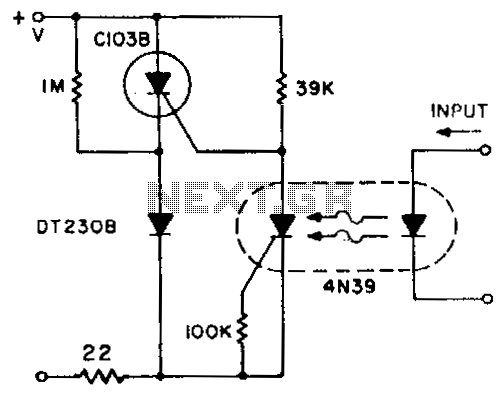
Normally-closed-half-wave

A normally closed contact circuit that provides zero-voltage switching is designed around the 4N39 SCR optocoupler. The circuit illustrates the method of modifying the normally open contact circuit by using the photo SCR to hold off the trigger SCR.
The circuit utilizes the 4N39 optocoupler, which is a device that combines an LED and a phototransistor in a single package, allowing for electrical isolation between its input and output. In this application, the optocoupler serves as a means to control the triggering of a silicon-controlled rectifier (SCR) while ensuring that the circuit remains in a normally closed state until a specific condition is met.
In a typical configuration, the input side of the 4N39 is connected to a control signal that activates the LED. When the LED is energized, it emits light that activates the phototransistor within the optocoupler. This action allows current to flow through the output side, which is connected to the gate of the SCR. The SCR remains off until the phototransistor conducts, providing a zero-voltage switching condition. This means that the SCR can be triggered to conduct without the risk of voltage spikes, which is beneficial for protecting sensitive components in the circuit.
The modification of the normally open contact circuit involves using the photo SCR to hold off the trigger SCR until the appropriate conditions are met. When the control signal is removed, the LED in the optocoupler turns off, causing the phototransistor to cease conduction. This action effectively turns off the SCR, returning the circuit to its normally closed state.
This configuration is particularly useful in applications requiring isolation between control and power circuits, such as in industrial automation, where it is essential to prevent high voltages from affecting low-voltage control signals. Additionally, the zero-voltage switching feature minimizes electromagnetic interference (EMI) and prolongs the life of the components by reducing wear associated with high-voltage switching.
Overall, this normally closed contact circuit design using the 4N39 SCR optocoupler exemplifies an effective approach to achieving reliable control in electronic systems while maintaining safety and efficiency.A normally closed contact circuit that provides zero-voltage switching is designed around the 4N39 SCR optocoupler. The circuit illustrates the method of modifying the normally open contact circuit by using the photo SCR to hold off the trigger SCR. 🔗 External reference
The circuit utilizes the 4N39 optocoupler, which is a device that combines an LED and a phototransistor in a single package, allowing for electrical isolation between its input and output. In this application, the optocoupler serves as a means to control the triggering of a silicon-controlled rectifier (SCR) while ensuring that the circuit remains in a normally closed state until a specific condition is met.
In a typical configuration, the input side of the 4N39 is connected to a control signal that activates the LED. When the LED is energized, it emits light that activates the phototransistor within the optocoupler. This action allows current to flow through the output side, which is connected to the gate of the SCR. The SCR remains off until the phototransistor conducts, providing a zero-voltage switching condition. This means that the SCR can be triggered to conduct without the risk of voltage spikes, which is beneficial for protecting sensitive components in the circuit.
The modification of the normally open contact circuit involves using the photo SCR to hold off the trigger SCR until the appropriate conditions are met. When the control signal is removed, the LED in the optocoupler turns off, causing the phototransistor to cease conduction. This action effectively turns off the SCR, returning the circuit to its normally closed state.
This configuration is particularly useful in applications requiring isolation between control and power circuits, such as in industrial automation, where it is essential to prevent high voltages from affecting low-voltage control signals. Additionally, the zero-voltage switching feature minimizes electromagnetic interference (EMI) and prolongs the life of the components by reducing wear associated with high-voltage switching.
Overall, this normally closed contact circuit design using the 4N39 SCR optocoupler exemplifies an effective approach to achieving reliable control in electronic systems while maintaining safety and efficiency.A normally closed contact circuit that provides zero-voltage switching is designed around the 4N39 SCR optocoupler. The circuit illustrates the method of modifying the normally open contact circuit by using the photo SCR to hold off the trigger SCR. 🔗 External reference